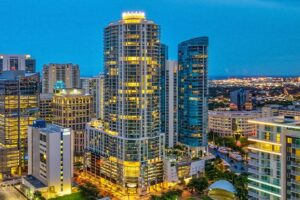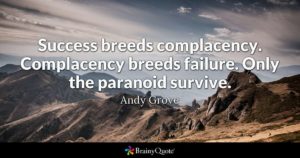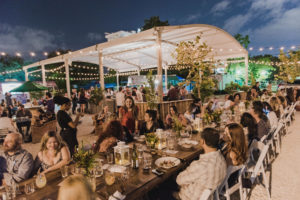
Here’s a picture of a buidling you will never see in Delray.
I took a 5-minute stroll through Facebook recently and saw the following written about our town—Delray Beach.
“So glad I moved away.”
“My wife and I live a few minutes from downtown. We wouldn’t be caught dead there.”
“There is no difference between Delray and Fort Lauderdale.”
There was more—a lot more— but that last gem is my favorite; that’s the one trope that jumps off the screen and disturbs every fiber of my being.
I mean have you been to Fort Lauderdale lately?
Have you seen 100 Las Olas? It’s 46 stories and 499 feet tall.
In the last thirty years, the tallest building built in downtown Delray Beach is 6 stories high, and you can’t even build that anymore.
The downtown height limit has been lowered to 54’ from 60 feet and along Atlantic Avenue the height limit is 35’. There’s a big difference between Delray Beach and Fort Lauderdale.
A big difference.
And because of efforts—(mostly forgotten or flat out ignored) to maintain the city’s scale—we will never be Fort Lauderdale.
Let me repeat that, because you are sure to get a blizzard of campaign mail saying otherwise as we enter election season in Delray Beach.
We.
Will.
Never.
Be.
Fort Lauderdale.
We won’t be Boca Raton or Boynton Bach either—both of those cities allow much taller buildings than Delray does.
I apologize if this is personal for me, but I know the people who devoted their careers to creating something pretty special in Delray Beach. So, while people have a right to their opinions, it stings a little when you see criticism that— to put it plainly—is not rooted in facts.
Again, people are entitled to their opinions and if we are wise, we should listen to all views. But at some point, we have put unreasonable fears to bed. We will never be Fort Lauderdale.
Still, truth be told, our downtown, while vibrant, may no longer be everyone’s cup of tea anymore. Personally, I find the crowds to be a little daunting at times, and the feel is less village like and more Bourbon Street these days. Some people like it, some people don’t.
But that’s a different conversation, isn’t it?
That conversation is not about whether a building is one-story or three, it’s about demographics and changes that some may love, and others may loathe.
But the misleading vitriol gets old. And it’s used to scare people and demonize investors. I think that’s wrong. And it needs to be called out.
It also ignores some pertinent facts: Delray Beach is a good place.
And so, I ask, where is the civic pride?
Where is the acknowledgement that in the 1980s, we were blighted, and crime riddled with families looking to flee to other cities because parts of this place were circling the drain?
Yes, we’ve changed. That’s a given. To my mind, change is of a fact of life: death, taxes, and change. You can count on all three.
That said, I think we’ve done well. We’re a busy town. A vibrant place. As Yogi Berra once said: “nobody goes there anymore. It’s too crowded.”
Indeed.
The sky has been falling for 30 years.
As we embark on yet another campaign season in Delray Beach, you will begin to see and hear a steady drumbeat of misinformation. Much of the noise you’ll hear pertains to the villainization of the development community. The group, which by the way happens to include some of our very best citizens, is a reliable punching bag.
As Yogi also said: “It’s déjà vu all over again.”
To be sure, we ought to care about what gets built here and what it looks and feels like. And trust me a whole lot of smart people have spent a lot of time trying to craft codes to ensure that Delray keeps its human scale.
To wit, we have never granted a waiver or a variance for height, and there is currently no mechanism to increase density beyond 30 units to the acre downtown, unless— and only in some districts—you add workforce housing. Workforce housing is a good thing. We need a place for our workforce to live if we hope to be a real community.
Most places on planet earth do not consider 30 units to the acre overly dense (especially for a downtown) and besides it’s the design that matters. I can show you plenty of low-density projects that won’t win any beauty pageants and a few “high” density projects that look sharp.
Instead, we fight over whether a building should be 3 stories or 4, when we really should be focusing on design and whether the architecture enhances or takes away from the streetscape and the pedestrian experience.
Many don’t like multifamily development, but where are essential workers supposed to live? Isn’t that a better discussion to be having? Also, while we are at it, is it possible that a lot of the traffic we bemoan is the workforce having to drive miles and miles to get to their jobs in our eastern communities because of a lack of affordability?
I live across the street from a large apartment complex called Delray Station.
I’m on Lake Ida Road every day during the morning and the evening rush. I have never seen more than three cars coming out of that development at a given time and I’m looking every day. The truth is that people behave differently these days, some work at home, some work a hybrid schedule, some have odd hours and therefore don’t clog our roads during the traditional rush. Of course, these are all theories, but I can honestly say that I don’t even know those apartments are there. It has had no appreciable effect —one way or the other— on Lake Ida Road. Just my opinion….
It’s also my belief that the big bad developers that we all fear are not all that big or bad.
Like any other profession, there are good developers and there are bad ones. We’ve had some good ones—developers who have done solid work and given back, and we’ve had a few who were strip miners looking to take all the gold out of the ground without giving anything back.
All in all, I think the good ones far outweigh the bad ones.
If you look at philanthropy in our town, you will see developers digging deep to support local nonprofits.
You’ll see others giving their time, which is our most valuable resource. They are not volunteering so they can get a variance, they care about this place. Many of them live here. They are not in business to ruin their hometown.
I see these often vilified and lied about people creating jobs, allowing others to open businesses, and providing much needed housing.
We need more housing not less. For teachers, police officers, firefighters, restaurant workers, etc.
In Palm Beach County, 92,000 non-family households make less than $35,000 a year, according to the Florida Housing Innovations Council; 8,800 of those households are in Delray Beach. In fact, 41 percent of non-family households (individuals, roommates) make under $35,000 per year. Delray is the only city in south or central Palm Beach County where non-family households outnumber families and we have a disproportionate need for both affordable housing and what many call the missing middle; housing that isn’t for low-income people but for working families.
Based on fundamental economics—supply and demand—we can never meet this need unless we increase the supply. And yet…we fight endlessly over height and density.
I find this ironic because there as noted before there is no mechanism to increase either regardless of what your told by some politician seeking your vote by making you fearful that one day you will wake up and Delray will look like Fort Lauderdale.
Waivers and variances exist—for things like sight lines and other stuff that you sometimes need to make infill projects work.
But you can’t build taller or denser than the code allows, period, end of story despite the poop that gets shoveled at us (often anonymously) during our exhausting election season.
So, I think we ought to flip the script.
Let’s remain vigilant about development, let’s keep our human scale, let’s put the screws to developers on design and insist on great architecture but let’s call out the NIMBY’s (Not in My Backyard) types too. The peeps who oppose everything regardless of property rights (we do live in America) and regardless of whether the developer follows local land use rules.
Let’s ask them where our teachers, nurses, children, grandchildren, and young families or middle-income retirees should live.
Let’s call out the “I’m in the boat pull up the ladder” charmers who don’t think about working families or those looking to come back after going away to college or the military. Let’s ask them why the people who serve our community shouldn’t be able to live here.
Editor’s note:
We mourn the loss of Supreme Court Justice Sandra Day O’Connor who passed last week at the age of 93.
Justice O’Connor came to Delray Beach years ago and I had the distinct pleasure of greeting her when she gave a speech at Old School Square.
She was a kind person and as the first female justice, an historic figure in American history. She gave an amazing speech.
What a life. Her service to our nation will be remembered.








